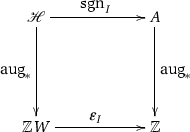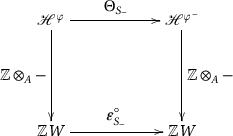Abstract
The aim of this chapter is to recall the basic properties of Hecke algebras (definition, parabolic subalgebras, involutions, symmetrizing form) in a suitable way with respect to our needs. In particular, the normalization of the parameters used here is tailor-made for applications to Kazhdan-Lusztig theory.
Access this chapter
Tax calculation will be finalised at checkout
Purchases are for personal use only
Author information
Authors and Affiliations
Corresponding author
Appendices
Notes
All the results gathered in this chapter are classical and may almost all be found, for instance, in [Bou] or [GePf]. Note that Theorem 4.5.1 appeared in Kilmoyer’s Thesis [Kil] and was published in [CuIwKij]. More detailed bibliographical comments can be found in [GePf, §8.5].
Exercises
Exercise 4.1
(Type \({\varvec{G_2}}\)). As in Exercise 3.2, let us assume here that \(S=\{s, t\}\) with \(m_{st}=6\), so that (W, S) is of type \(G_2\). Here is the corresponding Coxeter graph:

Compute the generic r-polynomials for W.
Exercise 4.2
(Direct products). As in Exercise 3.2, assume that \(S=S_1 \dot{\cup }S_2\) is a partition such that, if \(s_1 \in S_1\) and \(s_2 \in S_2\), then \(m_{s_1s_2}=2\) (i.e. \(s_1s_2=s_2s_1\)). Let \(W_i=W_{S_i}\) (\(i \in \{1,2\}\)). Let \(\varphi _i\) denote the restriction of \(\varphi \) to \(S_i\) and let \({\mathscr {H}}_i={\mathscr {H}}_A(W_i, S_i,\varphi _i)\). Show that
and that, if \((x_1,x_2)\) and \((y_1,y_2)\) are two elements of \(W_1 \times W_2\), then
Exercise 4.3
Let \(I \subset S\) and let \(a \in X_I\), x, \(y \in W_I\). Show that \({\varvec{r}}_{ax,ay}={\varvec{r}}_{x, y}\) and \({\varvec{r}}_{xa^{-1}, ya^{-1}}={\varvec{r}}_{x, y}\).
Exercise 4.4
The aim of this exercise is to prove the last statement of Example 4.1.8. Let \(\lambda \) and \(\mu \) be two elements of A and let T be an indeterminate over A. Let \({\mathscr {H}}_1=A[T]/\langle (T-\lambda )(T-\mu ) \rangle \) and
We aim to prove that \({\mathscr {H}}_1 \simeq {\mathscr {H}}_2\) whenever \(\lambda \ne \mu \) and A is an integral domain.
-
(a)
Show that \({\mathscr {H}}_2\) is indeed a subring of \(A \times A\).
-
(b)
Let \(\pi : A[T] \rightarrow A \times A\), \(P \mapsto (P(\lambda ), P(\mu ))\). Show that \(\pi \) is a morphism of A-algebras, whose image is \({\mathscr {H}}_2\).
-
(c)
Assume here that \(\lambda \ne \mu \) and that A is an integral domain. Show that \({{\mathrm{{\mathrm {Ker}}}}}(\pi )\) is generated by \((T-\lambda )(T-\mu )\). Conclude.
Exercise 4.5
Let I and J be two subsets of S. Show that
Exercise 4.6
Let \({{\mathrm{{\mathrm {aug}}}}}: {\mathscr {A}}\rightarrow \{1\}\) be the trivial morphism. Then \({{\mathrm{{\mathrm {aug}}}}}_* : A \rightarrow {\mathbb {Z}}\) is the augmentation morphism and it induces an isomorphism
Now, let I be a W-closed subset of S.
-
(a)
Show that there is a unique morphism of A-algebras \({{\mathrm{{\mathrm {sgn}}}}}_I : {\mathscr {H}}\rightarrow A\) such that
$$ {{\mathrm{{\mathrm {sgn}}}}}_I(T_s)= {\left\{ \begin{array}{ll} -v^{-\varphi (s)} &{} \mathrm{if}\,\, s \in I,\\ v^{\varphi (s)} &{} \mathrm{if}\,\, s \in S \setminus I. \end{array}\right. } $$If necessary, \({{\mathrm{{\mathrm {aug}}}}}_*\) and \({{\mathrm{{\mathrm {sgn}}}}}_I\) are denoted by \({{\mathrm{{\mathrm {aug}}}}}_*^\varphi \) and \({{\mathrm{{\mathrm {sgn}}}}}_I^\varphi \), respectively.
-
(b)
Show that the diagram

is commutative (here, \(\varepsilon _I : {\mathbb {Z}}W \rightarrow {\mathbb {Z}}\) is the morphism of algebras induced by the morphism of groups \(\varepsilon _I : W \rightarrow \{1,-1\}\) defined in Exercise 3.5).
-
(c)
Keep the notation of §4.3.C (\(S_+\), \(S_-\), \(\varphi _-\),...). Show that the diagram

is commutative (here, \(\varepsilon _I^\circ : {\mathbb {Z}}W \rightarrow {\mathbb {Z}}W\) denotes the automorphism of \({\mathbb {Z}}W\) such that \(\varepsilon _I^\circ (w)=\varepsilon _I(w)w\) for all \(w \in W\)).
Exercise 4.7
Assume that W is finite. If \(h \in {\mathscr {H}}\), let \(\det (h,{\mathscr {H}})\) denote the determinant of the map \({\mathscr {H}}\rightarrow {\mathscr {H}}\), \(h' \mapsto hh'\). Show that
for all \(w \in W\). (Hint: If \(w=s \in S\), use the decomposition \({\mathscr {H}}=\mathop {\bigoplus }_{x \in X_s} \bigl (A T_{x^{-1}} \oplus AT_{sx^{-1}}\bigr )\)).
Rights and permissions
Copyright information
© 2017 Springer International Publishing AG, part of Springer Nature
About this chapter
Cite this chapter
Bonnafé, C. (2017). Hecke Algebras. In: Kazhdan-Lusztig Cells with Unequal Parameters. Algebra and Applications, vol 24. Springer, Cham. https://doi.org/10.1007/978-3-319-70736-5_4
Download citation
DOI: https://doi.org/10.1007/978-3-319-70736-5_4
Published:
Publisher Name: Springer, Cham
Print ISBN: 978-3-319-70735-8
Online ISBN: 978-3-319-70736-5
eBook Packages: Mathematics and StatisticsMathematics and Statistics (R0)



